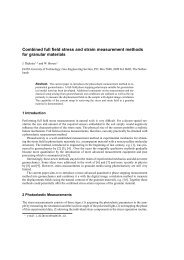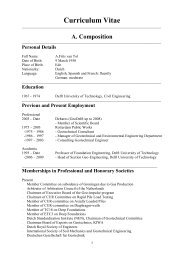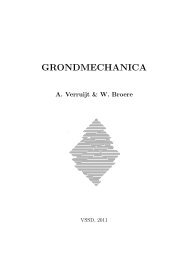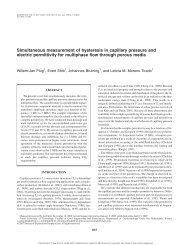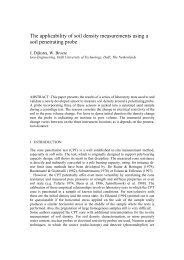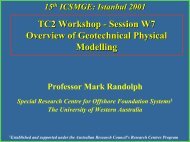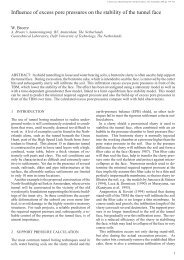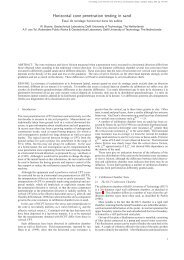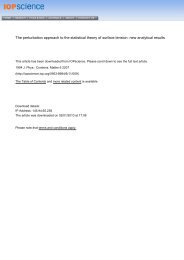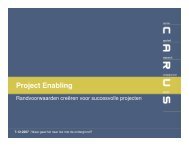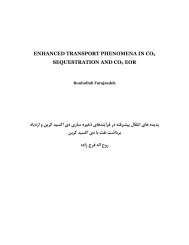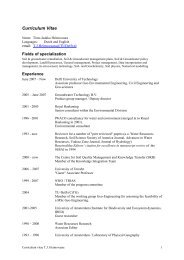Tunnel Face Stability & New CPT Applications - Geo-Engineering
Tunnel Face Stability & New CPT Applications - Geo-Engineering
Tunnel Face Stability & New CPT Applications - Geo-Engineering
Create successful ePaper yourself
Turn your PDF publications into a flip-book with our unique Google optimized e-Paper software.
52 2. <strong>Stability</strong> Analysis of the <strong>Tunnel</strong> <strong>Face</strong>the other hand. How this relationship depends on the separate parameters will be investigatedin the next section.The stability model presented in this section is a logical extension of the limit equilibriummodels used to investigate the stability of slurry-filled trenches and has been proposed in similarform by other authors. The model presented here differentiates itself as it can deal withheterogeneous soils and takes the effects of slurry infiltration as well as excess pore pressuresinto consideration. Based on the preliminary analysis presented above, the model behaves asexpected, but a more thorough analysis will be made in the following sections. First a parameteranalysis of the model will be carried out and then the model results will be compared to fieldobservations from several tunnelling projects in soft, heterogeneous and water-bearing soils.2.3 Model Sensitivity AnalysisThe calculations made with the basic model in the previous section show that the model has astrong non-linear dependence on the variation of the position of the layer boundary and on theresulting variation in soil parameters. It does not show however which individual parametersinfluence the results most strongly. To that end a more systematic investigation of the sensitivityto the various input parameters and several model choices will be made. First the individualparameters will be investigated, for which Reference <strong>Tunnel</strong> No. 1 will be used. As it willbecome clear that several parameters are in reality coupled, a few calculations will be madeusing sets of coupled parameters, simulating different soil types. Then an analysis will be madeof the sensitivity of the model in a heterogeneous, two-layer, system to the parameters that themodel is most sensitive to. Finally some remarks regarding the safety philosophy and safetyfactors will be made.The results of the calculations are presented as s, the difference between the supportpressure and the water pressure at rest, i.e. excluding excess pore pressures generated by theboring process. In most cases, except where noted otherwise, the water table used is equal tothe soil surface.2.3.1 Homogeneous SystemThe first analysis will be made based on reference tunnel No. 1, described on page 48. For eachof the parameters a variation interval around the reference value has been chosen (see table 2.9).Within this interval a number of calculations has been made in order to get a reasonable overviewof the model’s behaviour as a function of the variation of each separate parameter. For mostparameters the boundaries of the variation interval have been chosen very wide, to include anyreasonable variation that might occur in practice. As the leakage factor λ is the main parameterfor the groundwater flow and thereby governs the excess pore pressure distribution, this analysishas been repeated for three different reference values of λ: λ ≫ D, λ ≈ D and λ ≪ D. Theresulting excess minimal support pressures are presented in figure 2.44, with the exception of theinfluence of the water level z h which has been presented in figure 2.45. In these graphs the dotsindicate the excess minimal support pressure for the reference case. The chosen values of theleakage factor are: (a) λ = 1342m, (b) λ = 6m and (c) λ = 0.06m. For case (b) the gradient ofthe excess minimal support pressure around the reference point, as well as the maximal gradient,have also been listed in table 2.10. The same data is also presented in figure 2.46, scaled to theexcess support pressure found for the reference case, s ref , so the relative influence of the various



